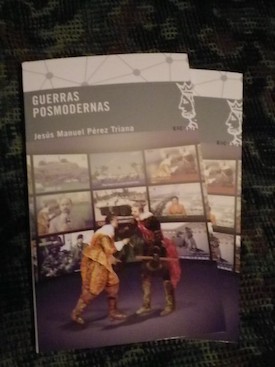Las olas del terrorismo y las insurgencias del futuro
"Las olas del terrorismo y las insurgencias del futuro (The waves of terrorism and the insurgencies of the future)" by Jesús M. Pérez Triana, the author of Guerras Posmodernas (Barcelona: Ediciones El Cobre, 2010). Pérez Triana, a Spanish sociologist, national security, and intelligence analyst explores future conflicts and post-modern wars in a three part series in Spanish at The Political Room.

The first essay, "Las olas del terrorismo y las insurgencias del futuro (I)," looks at the 'waves' of terrorism articulated by eminent terrorism scholar David C. Rapoport, Distinguished Professor Emeritus at the University of Southern California,[1] Los Angeles and founding editor of Terrorism and Political Violence.
The second, "Las olas del terrorismo y las insurgencias del futuro (II)," examines the evolution of insurgency, looking at Robert J. Bunker's works on Old and New Insurgency Forms,[2] including 'criminal insurgency' as articulated by John P. Sullivan,[3] and 'plutocratic insurgency.'[4]
The third and most recent, "Las olas del terrorismo y las insurgencias del futuro (III)," continues the exploration of post-modern wars by reviewing the rise of 'bloody sectarian' insurgency and terrorism:
"La primera forma emergente señalada por Robert J. Bunker es la 'sectaria sangrienta'. Se trata de grupos armados articulados en torno a una secta religiosa con 'prácticas sectarias, mundos utópicos, anhelos apocalípticos e incluso prácticas de sacrificios humanos (The first emerging form identified by Robert J. Bunker is the 'bloody sectarian.' These are armed groups articulated around a religious sect with 'sectarian practices, utopian worlds, apocalyptic yearnings and even human sacrifice practices'.)"[5]
The second form of new insurgency and terrorism identified by Bunker is 'neo-urban' with the rise of armed groups in 'feral cities.' The potential for 'virtual' insurgencies that operate solely and exclusively in the "ámbito de las redes de información (realm of information networks)" is also discussed.[6]
These three essays bring the work on emerging insurgency and terrorism to Spanish speaking reader. This blog note completes the circle and brings awareness of the discussion of criminal insurgencies in the Spanish literature to English-speaking readers. Pérez Triana tweets at @jpereztriana, he also blogs in Spanish at "Guerras Posmodernas."
Endnotes
[1] David C. Rappoprt, :"The Four Waves of Modern Terrorism" in John Horgan and Kurt Braddock, Eds. Terrorism Studies: A Reader. New York: Routledge. 2008, pp. 46-72.
[2] Robert J. Bunker, Old and New Insurgency Forms. Carlisle Barracks: Strategic Studies Institute, US Army War College, 2016.
[3] John P. Sullivan,"Transnational gangs: The impact of third generation gangs in Central America." Air & Space Power Journal−Español. Second Trimester (January) 2008.
[4] Robert J. Bunker and Pamela Liguri Bunker, Eds., Plutocratic Insurgency Reader. (A Small Wars Journal Book.) Bloomington: Xlibris. 2019.
[5] Here Pérez Triana cites Bunker, Old and New Insurgency Forms.
[6] Ibid.
